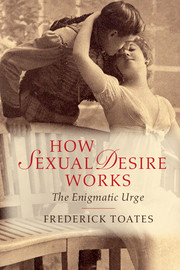Book contents
- Frontmatter
- Dedication
- Contents
- List of figures
- Preface
- One What is enigmatic about sexual desire?
- Two Explaining desire: multiple perspectives
- Three Sexual desire in a broad context
- Four An incentive-based model
- Five Sex and levels of organization
- Six Sexual attraction
- Seven Shades of desire from simple to complex
- Eight Details of the brain and desire
- Nine Arousal
- Ten The consequences of sexual behaviour and associated expectations
- Eleven Sexual familiarity and novelty
- Twelve Inhibition, conflict and temptation
- Thirteen How did sexual desire get here?
- Fourteen Setting the trajectory: link to adult sexuality
- Fifteen Sexual desire in interaction
- Sixteen Representations of sex
- Seventeen Sexual addiction
- Eighteen Variations in desire: general principles
- Nineteen Some forms of desire at the fringes
- Twenty The toxic fusion: violence and sexual desire
- Twenty one Sexually associated (serial) murder
- Twenty two Concluding remarks
- Notes
- References
- Index
Fourteen - Setting the trajectory: link to adult sexuality
Published online by Cambridge University Press: 05 October 2014
- Frontmatter
- Dedication
- Contents
- List of figures
- Preface
- One What is enigmatic about sexual desire?
- Two Explaining desire: multiple perspectives
- Three Sexual desire in a broad context
- Four An incentive-based model
- Five Sex and levels of organization
- Six Sexual attraction
- Seven Shades of desire from simple to complex
- Eight Details of the brain and desire
- Nine Arousal
- Ten The consequences of sexual behaviour and associated expectations
- Eleven Sexual familiarity and novelty
- Twelve Inhibition, conflict and temptation
- Thirteen How did sexual desire get here?
- Fourteen Setting the trajectory: link to adult sexuality
- Fifteen Sexual desire in interaction
- Sixteen Representations of sex
- Seventeen Sexual addiction
- Eighteen Variations in desire: general principles
- Nineteen Some forms of desire at the fringes
- Twenty The toxic fusion: violence and sexual desire
- Twenty one Sexually associated (serial) murder
- Twenty two Concluding remarks
- Notes
- References
- Index
Summary
We’ve come a long way culturally in 10,000 years but evolutionary psychologists would argue that if we are to understand the human mind then we would do well to realise that that mind is the same one that scanned the plains of equatorial Africa in days of our Pleistocene ancestors.
(Workman and Reader, 2014, p. 470)The last chapter looked at how the bases of sexual desire are established in the child. The present chapter revisits this topic in the context of how processes established in the child are revealed in:
the emergence of adult sexual behaviour;
changes and stability in adult behaviour.
It first looks at how brain development is manifest in sexual risk-taking (by also drawing on earlier chapters that described levels of the control of behaviour) and it then considers the direction taken by adult sexual desire and expression.
Transitions between adolescence and young adulthood: brain bases
Adolescence and young adulthood represent a stage during which there is a strong tendency to engage in risky activities, including dangerous driving, drug-taking and unsafe sexual behaviour (Steinberg, 2008). For many, it is the time of first sexual intercourse (Hawes et al., 2010). Educational programmes designed to warn of risky activities by appealing to rational cognition appear to have a very limited effect. Do young people fail to appreciate the risks, as a result of using wrong and irrational calculations? Do they trust in their own invulnerability? It is not a failure of knowledge; the beliefs and calculations of 16-year-olds are much like those of adults.
- Type
- Chapter
- Information
- How Sexual Desire WorksThe Enigmatic Urge, pp. 245 - 268Publisher: Cambridge University PressPrint publication year: 2014



